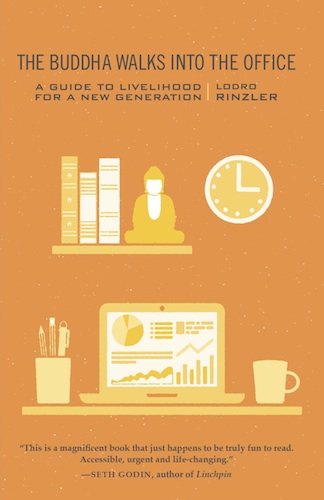We’re honored to have the exclusive privilege to share up the first excerpt from our colleague and friend Lodro Rinzler’s new book. Lodro, a leading young Buddhist teacher, offers meditation and Buddhist wisdom outside of the choir in an accessible, genuine, fun manner. May it be of benefit!
~ Waylon Lewis, ed.
~
The Buddha Walks into the Office: Be Who You Want to Be
When I was seven years old, my first-grade teacher asked everyone to draw what they wanted to be when they grew up. I remember walking around my classroom during parent-teacher night with the room plastered with drawings, learning all about my classmates’ long-term aspirations. Who knew? It was a room full of aspiring astronauts and baseball players.
I have to admit, I was the odd man out. My picture portrayed a man hunched over a typewriter, working away at his book. Even recalling that image today makes me sit up straight at the keyboard.
A few years ago, at dinner with my friend Laura, I was talking about my writing she about her impending graduation from social work school. Both of us felt on the cusp of something career- like but we had to pause and acknowledge that this year was the first time in our lives we had really revisited that old idea of “what do you want to be when you grow up.” We started mapping out the trajectories for all of our mutual friends. They too had hit their late twenties and were all of a sudden scrambling to figure out what they wanted to do with the rest of their lives.
It occurred to me that given the current educational and economic situation in the United States, maybe the question of what you want to be when you grow up is outdated. This conversation steered me toward what is perhaps a better question for the thoughtful young person of today: “Who do you want to be when you grow up?”
I found that in determining who you want to be when you grow up, it is helpful to physically map some things out for yourself. And a mandala can be useful as a map. One translation of the Sanskrit word mandala is “circle.” It is a diagram often used in Buddhism to depict the abode of a deity or a microcosm of the universe. A mandala can be viewed in some respect as a sort of organizational chart.
The idea is that what is at the center of the mandala influences everything else in it. We can think of our lives and livelihood in those terms. Here is a fun exercise I encourage you to engage in:
1) Copy the diagram above by drawing a circle, then drawing three to five circles around it, in a concentric manner
2) Meditate for ten minutes
3) Toward the end of that meditation session, ask yourself, “What qualities do I want to cultivate in myself?”
4) Write those qualities down on a separate piece of paper. Be concise—just a few words will do. It might be kindness, sincerity, wisdom, or something equally personal to you.
5) Look at those qualities. Let your mind rest on them. As you rest your mind, discern which feel most pertinent.
6) If there is one that really stands out, write that down at the center of your mandala. For some people it might read feeling less stressed-out all the time or being more gentle or practicing compassion. Try to make it a quality rather than a job title.
7) In the circle outside of that core, write down some people or things that are important to you. You might write the names of family members or the name of your partner, or hobbies you engage in, or (I recommend this one) what you do or aspire to do for a living. Continue in the next circle out with other aspects of your life. Do you run? Put that in there. Do you like museums? Singing? Put those down. Continue to fill out the circles you provided for yourself with various aspects of your life. The more important they are to you, the closer they belong to that innermost circle.
8) Draw a line from the core of the mandala to each of those things you have written down.
9) On each of those lines, write how you might want your core motivation to influence that aspect of your life. For example, if you wrote down kindness, what would shift in that connection to your boss? What would shift in how you spend your money? What would shift in how you exercised?
10) When you are done writing, place the paper aside and rest with whatever feelings have come up. Then return to formal shamatha meditation, staying with your breath for five minutes.
When you engage in an exercise like the ten steps earlier, you are switching your focus from questions about what you ought to be doing with your career and instead embracing an idea of who you want to be. This will be helpful as you engage your career path, because you can always cultivate the qualities that are important to you, whereas you may not always be able to make a living doing exactly what you want to do.
Now, imagine for a moment a world where an entire generation took the view that it is more important that they determine who, not what, they want to be when they grow up. Some would still become baseball players and astronauts, but they would engage their work with the values that are most important to them.
~
Adapted and excerpted from The Buddha Walks into the Office, by Lodro Rinzler, © 2014 by Lodro Rinzler. Reprinted by arrangement with Shambhala Publications, Inc., Boston, MA. In bookstores September 9th, 2014. www.shambhala.com
~
Love elephant and want to go steady?
Sign up for our (curated) daily and weekly newsletters!
Editor: Rachel Nussbaum
Photo: Lodro Rinzler













Read 0 comments and reply